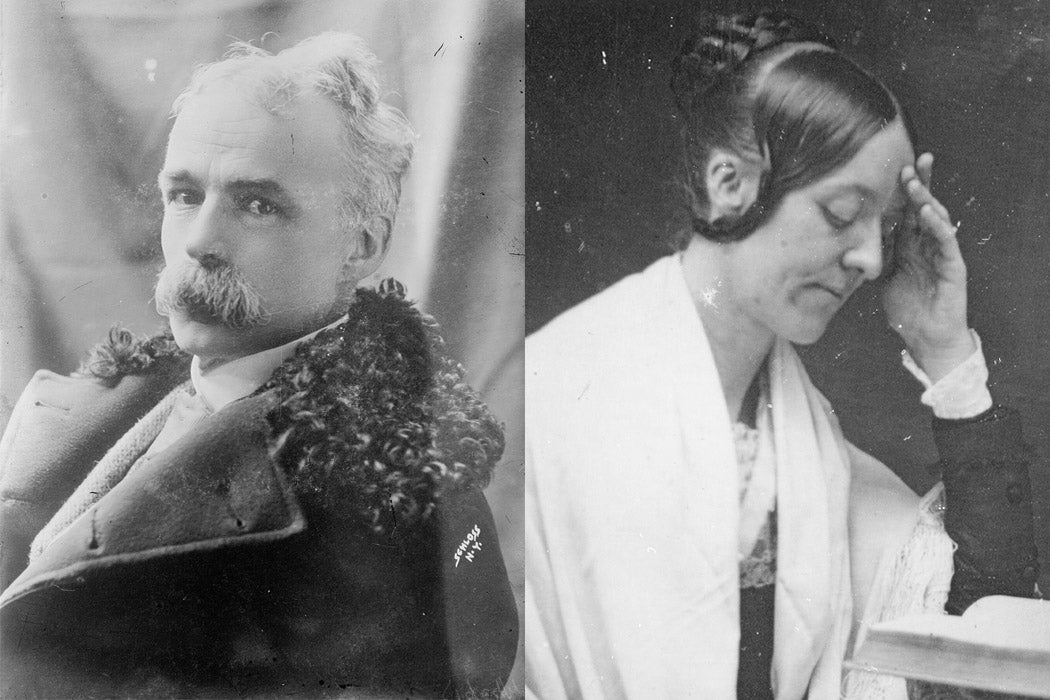Margaret Fuller has had a remarkable posthumous career. In 1850, the year she drowned in a shipwreck just off Long Island, Ralph Waldo Emerson sent Henry David Thoreau to find her corporeal and literary remains. Fuller had been traveling back to America with her manuscript history of the Italian revolution, her lover Giovanni Angelo Ossoli, and their son Angelino. Only the child’s body was ever found. Emerson ended up helping to edit the two-volume Memoirs of Margaret Fuller Ossoli (1852), largely turning them into his memoirs of her.
As writer, editor, and foreign correspondent, Fuller was one of the most read American authors in her lifetime. She continued to be well read after her death—for three decades, anyway.
In 1869, Horace Greeley, who had hired her as the first woman journalist at the New York Tribune, issued a six-volume edition of her works. He called her “the most remarkable, and in some respects the greatest, woman whom America has yet known.” Meanwhile, the Memoirs were reprinted eleven times by the 1880s. Fuller’s Woman in the Nineteenth Century, originally published in 1845 as one of the first feminist works in the US, was printed nine more times by 1884. Another collection of her work, edited by her brother, was reprinted ten times.
The year 1884 saw the publication of two laudatory Fuller biographies by eminent people who had known her, Julia Ward Howe and Thomas Wentworth Higginson. Howe is best remembered today for penning the “Battle Hymn of the Republic.” Higginson was one of John Brown’s Secret Six supporters and Emily Dickinson’s epistolary mentor. Higginson’s biography was one of the first of Houghton Mifflin’s American Men of Letters series.
Then came Julian Hawthorne. The second child of Nathaniel and Sophia Peabody Hawthorne, Julian (born 1846) successfully torpedoed Fuller’s reputation, the damage lasting for decades. As scholar Thomas R. Mitchell details, in late 1884, Julian
intentionally provoked a literary scandal that he hoped would realign and strengthen his father’s position in literary history even as he destroyed Fuller’s. Though Julian’s two-volume Nathaniel Hawthorne and His Wife extended to almost 1,000 pages, the 2½ pages that he devoted to his father’s notebook entry on Fuller received almost the only detailed citation and comment from reviewers.
In that 1858 notebook entry, Nathaniel had described Fuller as having a “defective and evil nature.” As Mitchell notes, Julian used some clever editing of his father’s notes to portray Nathaniel in the best light and Fuller in the worst. Julian also did his best to shore up “anxiety” about his father’s masculinity.
Weekly Newsletter
Julian positioned Fuller as the antithesis of the “true love and married happiness” represented by his parents, portrayed as the great artist Nathaniel and the loving helpmate Sophia. (Mitchell notes that “Sophia greatly admired Margaret.”) Julian carried his attack into the newspapers, writing “Margaret Fuller has at last taken her place with the numberless other dismal frauds who fill the limbo of human pretension and failure.”
Fuller became the “tainted” and “fallen” woman because she had had a child out of wedlock with Ossoli. This was a powerful character smear in the American version of Victorianism. In addition to positioning his father in the canon, Julian was also gunning for the idea of the New Woman, feminism, and women’s rights.

Julian’s anti-Fuller campaign did serious damage. Woman in the Nineteenth Century didn’t have a twentieth-century publication until 1969. The Memoirs didn’t see a new edition until 1973. Writes Mitchell,
During the two crucial periods in which the American canon was institutionalized—the closing decades of the nineteenth century and its reformation in the third and fourth decades of the twentieth century—Margaret Fuller was simply out of print, and of course, out of the canon, each to some extent both cause and effect of the other.
Julian Hawthorne helped position his father in the pantheon of American literary geniuses but never entered it himself. In 1913—the year his ghost-story-writing daughter Hildegarde marched in a suffrage parade—he was convicted of mail fraud. He wrote an argument for prison abolition called The Subterranean Brotherhood as a result of his year in a federal prison. When he died in 1934, his ashes were spread along a California beach, a continent away from the beach Margaret Fuller was so close to at her death eighty-four years earlier.
Support JSTOR Daily! Join our new membership program on Patreon today.







